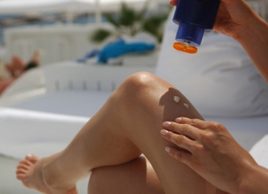Are all sunscreens safe?
No one likes dealing with the pain of a sunburn’but when it comes to protecting yourself, are all sunscreens a safe choice? Read on to find out what’s new in sunscreens and how to ensure you’re covered

Source: Best Health Magazine, Summer 2010
Despite warnings about the dangers of too much sun exposure and using tanning beds, skin cancer continues to rise by about one percent each year: In May, the Canadian Cancer Society estimated there will be 5,300 new cases of melanoma in Canada in 2010, and 920 deaths from the disease. More than 75,000 Canadians will be diagnosed with non-melanoma skin cancer and, of those, 280 are expected to die from it.
But even if it doesn’t prove deadly, ‘the less aggressive forms of skin cancer occur mainly on the face, and over time can destroy skin, muscle and bone, so they can cause significant disfigurement,’ says Dr. Jason Rivers, a clinical professor of dermatology at the University of British Columbia.
You don’t need to shun the sun: Consistently applying broad-spectrum sunscreen and practising safe sun habits (such as limiting your time outside when the sun is hottest at midday) should help you avoid skin damage and cancer. But remember to supplement your vitamin D intake to ensure ‘you get enough.
Is higher SPF better?
The Canadian Dermatology Association says a sun protection factor (SPF) of 30 is still the minimum standard for all-around sun protection. The SPF indicates how much the product will protect against ultraviolet B (UVB) rays (the shorter rays associated with sunburn, wrinkling and skin cancer).
Super-high SPFs (85 and 100) are now available at the drugstore. You may pay more for a higher SPF, but the UVB protection doesn’t increase accordingly. An SPF ’15 protects against 93 percent of UVB rays while SPF 30 gives 97 percent protection; ‘no sunscreen protects 100 percent. ‘The higher numbers are more of a gimmick,’ says Rivers, adding that the U.S. Food and Drug Administration (FDA) is working on making 50+ the highest SPF available in the U.S.
‘Theoretically, even an SPF 15 would work if you used it properly, but most people don’t put on enough to get the full protection,’ he says. You need to apply at least ’30 mL’that’s ‘two tablespoons’ worth’for full-body application. You should apply it 30 minutes before going outside and then reapply every two hours (or sooner if you’re swimming).
And that’s just part of the story. Up to ’95 percent of the UV rays that reach the skin are ultraviolet A (UVA) rays; they’re longer and penetrate deeper than UVB, and they also contribute to wrinkling, skin aging and skin cancer. Choose sunscreens that are labelled ‘broad spectrum.’ This indicates they offer both UVA and UVB coverage.
Unlike the SPF used for UVB rays, however, there are currently no labelling rules for indicating or measuring UVA rays.
Are sunscreens safe?
Says Rivers, pregnant women and children should consider avoiding sunscreens that contain the UVA absorber benzophenone-3, also known as oxybenzone. According to ‘the Environmental Working Group (EWG), ‘a U.S.-based non-profit health protection group, the chemical has been linked to low birth weight in girls whose mothers were exposed to it in pregnancy, and kids may be less able to detoxify and excrete such chemicals. And a 2008 University of California study on fish suggests oxybenzone may also affect reproduction. ‘In human studies we haven’t seen evidence of harmful effects, but we continue to follow the literature,’ says dermatologist Dr. Cheryl Rosen, national director of the Sun Awareness Program at the Canadian Dermatology Association.
Many people see blockers that contain zinc oxide and titanium oxide as ‘natural’ products although they are chemicals, says Rivers. (These UVA/UVB blockers scatter and deflect the sun’s rays, while sunscreens absorb them.) Because zinc and titanium can look white and pasty on the skin, some sunscreen products now contain them as microscopic nanoparticles so that they’ll spread easily and appear transparent.
Scientists have questioned the safety ‘of sunscreens containing nanoparticles, but it appears they are safe. According to a 2009 scientific review of studies by the Australian government’s Therapeutic Goods Administration’Australia is a world leader in the science of sun protection’there is evidence that nano-particles could interact with sunlight and cause skin cell damage. But the review concluded that this would be an issue only if nano-particles penetrated skin. In 2009, the EWG published a review of 16 scientific studies on the absorption of nano-‘particles, and found they don’t present a risk because they don’t penetrate the skin. Currently, Health Canada does not require manufacturers to list nanoparticles on sunscreen labels.
This article was originally titled "Safe in the Sun," in the Summer 2010 issue of Best Health. Subscribe today to get the full Best Health experience’and never miss an issue!’and make sure to check out what’s new in the latest issue of Best Health.




